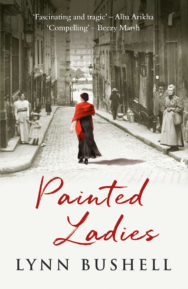‘He’s watching from the pavement opposite as if all this is a performance that I’m putting on to liven up the morning.’
Fictionalising the love lives of great artists is having a bit of a moment in publishing. We’ve had novels on Ernest Hemingway and Zelda Fitzgerald, and now Lynn Bushell is tackling the life and loves of Pierre Bonnard. Here she talks to BooksfromScotland about the real life story that inspired her book.
Painted Ladies
By Lynn Bushell
Published by Sandstone Press
Bonnard is almost unique amongst artists in that he was not a philanderer and although he had two mistresses, one of them was his common law wife Marthe, who remained with him for half a century. In 1917 when ‘Painted Ladies’ opens, she and Bonnard had already been together twenty-five years. He had met her on her way to the funeral parlour where she worked sewing artificial flowers onto wreaths. Recognising perhaps that Bonnard was a class above her she told him her name was Marthe de Méligny and that she was sixteen. It wasn’t until he married her in 1925 and she signed the register ‘Maria Boursin’ that he realised she had lied not just about her name, but her age. She had in fact been twenty-four at the time.
By then, however, the artist had other things on his mind. His affair with his model, the captivating eighteen year old Renée Montchaty, had been going on for five years and Bonnard had finally reached a decision. He told Marthe he was taking Renée to Rome and intended marrying her on their return. One can only imagine Marthe’s despair – approaching fifty, no longer beautiful and with a skin complaint that necessitated spending hours in the bath each day, she had been relying on Bonnard’s obsessive insistence on everything in his life remaining constant, to keep her in place until the affair had run its course.
We don’t know what happened in Rome. The one painting to come out of it shows two women in the Piazza del Popolo; one is holding up a set of scales. The pair returned to Paris prematurely and Bonnard went straight back to the house he shared with Marthe in St Germain-en-Laye and proposed to her instead. Three weeks after the marriage, Renée was dead. She was just twenty-four.
You could say Bonnard was unlucky. In trying to do right by one woman he had destroyed them both. He and Marthe fled to the south of France where they remained for the rest of their lives. Always reclusive, Marthe now made a career of being ill and developed a paranoid reluctance to see anyone. With an eye on posterity she insisted that any remaining images of Renée be destroyed. By the time of her death in 1942 the scandal had been forgotten, Bonnard was the ‘Grand Old Man’ of painting and Marthe was his acknowledged muse – ‘the woman in the bath’. She had even managed to turn her psoriasis to good use.
However, there was a curious post-script to the affair. In the last year of his life Bonnard returned to a painting he’d abandoned twenty-five years earlier and which Marthe must have overlooked in her war of attrition. In ‘The Women in the Garden’ we have virtually the only surviving image of Renée. Bonnard places her centre stage – young, beautiful and very much alive. He gilds the background so the painting resembles an icon. It’s only because the title is ‘The Women in the Garden’ that one’s eye looks for a second woman and there in the bottom right hand corner, buried in shadow and staring grimly at her rival, is Marthe.
It’s enough to cast doubt on the idea that Marthe was Bonnard’s muse and Renée was just a blip in his artistic career. The young woman who died so tragically and who’d been whited out of history, survived to tease historians a century later. In ‘The Colour of Memory’ Tate Modern’s Bonnard exhibition, ‘The Women in the Garden’ has pride of place. One can’t help thinking that poor Marthe would be turning in her grave.
Painted Ladies by Lynn Bushell is published by Sandstone Press, priced £7.99
ALSO IN THIS ISSUE

 Down to the Sea
Down to the Sea
‘All ten of the men and boys who’d gone to sea that day were dead, drowned. The fishwives said it wa …














